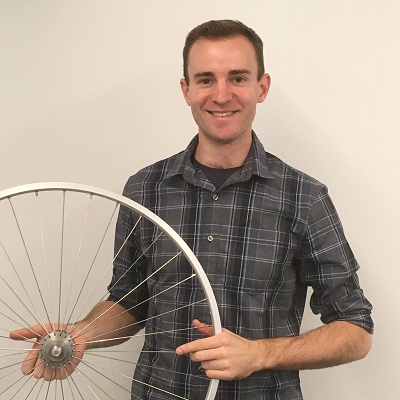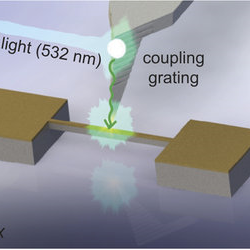Cornell Active Learning Initiative
I'm currently working as a postdoctoral teaching specialist with the Cornell Active Learning Initiative in the Sibley School of Mechanical and Aerospace Engineering. We are developing new curriculum for five junior-level courses to engage students with more interconnected, active, and inductive activities.
Reinventing the wheel
The tension-spoked bicycle wheel has endured for over 140 years due to its simplicity and elegance. Although materials and manufacturing techniques have continued to envolve, the basic design of the wheel has not significantly changed since the 1870s.

- Read my PhD Thesis: Reinventing the Wheel: Stress Analysis, Stability, and Optimization of the Bicycle Wheel
- Try out my interactive bicycle wheel simulator to compute the deformation and spoke tensions in a loaded wheel.
- Bicycle Magazine covered my ongoing collaboration with Jim Papadopoulos, formerly at Northeastern University.
M. Ford, P. Peng, O. Balogun. Acoustic Modal Testing of Bicycle Rims, Journal of Nondestructive Evaluation, 2018 (37) 16 (accepted manuscript, electronic supporting material, read online)
M. Ford and O. Balogun, "Analytical Model for the Radial Strength and Collapse of the Bicycle Wheel", International Cycling Safety Conference 2017, Davis, CA.
M. Ford, J.M. Papadopoulos, and O. Balogun, "Buckling of the bicycle wheel", Proceedings of the 2016 Bicycle and Motorcycle Dynamics Conference.
M. Ford, O. Balogun, "Buckling and collapse of the bicycle wheel", 24th International Congress of Theoretical and Applied Mechanics, Montreal, CA, August 2016.
Hands-on labs to support student agency
Under the new ABET criteria, students are expected to demonstrate "an ability to develop and conduct appropriate experimentation, analyze and interpret data, and use engineering judgment to draw conclusions" (ABET 2019). Traditional, recipe-based labs provide few opportunities for students to engage in realistic experimental design, and recent research has cast doubt on their pedagogical benefit (Holmes, et. al. 2018). At the same time, disruption due to the COVID-19 pandemic has forced institutions to move to virtual and geographically distributed learning.
I have developed virtual and hands-on collaborative "lab" activities for engineering students. No longer constrained by the narrow range of experiments that can be "properly" performed on an MTS, students faced and overcame more authentic engineering challenges by designing precise experiments with household materials.
- Watch my presentation at ASEE 2020 about adapting hands-on labs for remote instruction
- Watch some videos created by my students demonstrating common ASTM tests.
Hear it from my students:
"The collaborative labs were my favorite part. I can say with certainty that this has been one of the most informative courses I've taken so far at Cornell."
"He was continuously coming up with creative ways to exhibit concepts of the course that each student could replicate in their own homes."
M. Ford, Hands-on Labs for Remote Instruction. Presented at ASEE's Virtual Conference (2020).
Motivation and self-efficacy
Motivation is a multi-faceted construct encompassing orientation towards certain types of goals, the value and expectation of achieving those goals, and attributional beliefs.
Much of the literature on motivation in engineering has focused on persistence beyond introductory courses, career choice, and differences between engineering majors. However, our interviews with mechanical engineering students have revealed that students may form motivational beliefs and identities related to a specific subfield within their major (e.g. "I see myself as a mechatronics person, but not a fluids person") and therefore we expect to find differences in responses between course contexts for the same student.
- Our study tracks cohorts of students through the junior year, across time and course context.
- Our data set tracks students through the COVID-19 pandemic, allowing us to explore the effects of major disruption to academic life.
M. Ford, H. Ritz, E. M. Fisher, "Motivation, self-efficacy, and student engagement in intermediate mechanical engineering courses", ASEE's Virtual Conference (2020).
Dynamic near-field optical scanning microscopy
Optical microscopy is limited by the wavelength of light. But today's nano devices have features under 10 nanometers, orders of magnitude smaller than the wavelength of visible light! Scanning probe microscopy breaks this limit by using specially fabricated nanoprobes which use mechanical forces to map out feature topography or other properties. Near-field scanning optical microscopy (NSOM) combines an optical probe with a mechanical probe by using a sharp metal tip as an "optical antenna," which focuses a far-field laser source to a sub-wavelength hotspot.
We use this optical hotspot as a dynamic probe to measure mechanical vibrations. We are able to measure vibrations less than one picometer with a spatial resolution of just a few nanometers. This sensitive tool can be used to probe graphene devices, carbon nanotube resonators, or complex MEMS devices.
Ahn, X. Chen, Z. Zhang, M. Ford, D. Rosenmann, I. W. Jung, C. Sun, and O. Balogun. Dynamic near-field optical interaction between oscillating nanomechanical structures, Scientific Reports 5, 10058 (2015)
Multi-scale modeling of carbon nanotube yarns
Under construction
X. Wei, M. Ford, R. A. Soler-Crespo, H. D. Espinosa. A new Monte Carlo model for predicting the mechanical properties of fiber yarns, Journal of the Mechanics and Physics of Solids vol. 84, pp. 325-335. (2015).
A. M. Beese, M. Ford, et. al. Key Factors Limiting Carbon Nanotube Yarn Strength: Exploring Processing-Structure-Property Relationships, ACS Nano, 2014 (8) 11. pp. 11454-11466
...

My name is Matt Ford. I teach courses in mechanical engineering UW Tacoma. I received my Ph.D. from Northwestern University in Mechanical Engineering for my work on the mechanics of the bicycle wheel.


